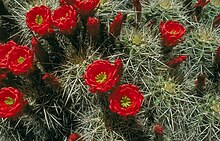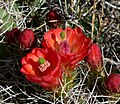Echinocereus triglochidiatus

| Echinocereus triglochidiatus | |
|---|---|
 | |
| Scientific classification | |
| Kingdom: | Plantae |
| Clade: | Tracheophytes |
| Clade: | Angiosperms |
| Clade: | Eudicots |
| Order: | Caryophyllales |
| Family: | Cactaceae |
| Subfamily: | Cactoideae |
| Genus: | Echinocereus |
| Species: | E. triglochidiatus |
| Binomial name | |
| Echinocereus triglochidiatus | |
| Synonyms | |
| List
| |

Echinocereus triglochidiatus is a species of hedgehog cactus known by several common names, including kingcup cactus, claret cup cactus, red-flowered hedgehog cactus and Mojave mound cactus. This cactus is native to the southwestern United States and northern Mexico, where it is a resident of varied habitats from low desert to rocky slopes, scrub, and mountain woodland. E. triglochidiatus is the official state cactus of Colorado.[3]
Description
[edit]A number of varieties of this highly variable cactus species are known, but not all are universally recognized. In general, it is a mounding cactus, forming bulbous piles of spherical to light to bluish green cylindrical stems, forming cushions over 1 meter in diameter with up to 500 shoots. Stems range from 5 to 40 cm long and 5 to 15 cm in diameter withfive to twelve ribs that are either straight-edged or tuberculated. It is densely spiny and somewhat woolly. The one to four central spines are similar to the peripheral spines, with up to 22 round or flattened, yellow to dark marginal spines that can be 1 to 7 cm long, though some may be absent. The showy flower is a funnel-shaped bloom up to 8–9 cm (3.1–3.5 inches) wide and bright scarlet red to orange-red tepals. A thick nectar chamber and many thready pink stamens are at the center of the corolla.[4] The fruits are spherical to obovate, slightly pink or reddish, and lose their thorns over time.[5] The chromosome count is 2n = 22.[6]
Subspecies
[edit]There are two recognized subspecies:[7]
Taxonomy
[edit]The kingcup cactus's taxonomy is a topic of contention. Varieties of the E. triglochidiatus often vary dramatically in their stems and spines, with closely related combinations producing radically different looking plants. Many varieties have little or no documented natural occurrences, but were observed in cultivation.[8]
Plants in the western portion of the range of E. triglochidiatus were formerly considered E. triglochidiatus var. mojavensis. This taxon included both the California curly-spined plants and the straight-spined plants that reside in Arizona, Utah, and western Colorado. The straight-spined varieties were called E. triglochidiatus var. melanacanthus. Those in the eastern portion of the distribution were called E. triglochidiatus var. triglochidiatus. They have fewer and larger spines.[9] These varieties became their own distinct subspecies, and only the E. triglochidiatus var. triglochidiatus is a recognized variant.[4]
One variety, E. t. arizonicus or the Arizona Hedgehog cactus, is federally listed as an endangered species in the United States. It is limited to the intersection of Arizona and New Mexico in the United States with Mexico. This variety is sometimes included within Echinocereus coccineus. Conversely, the Integrated Taxonomic Information System lists the variety as its own species, Echinocereus arizonicus.[10][11]
Distribution
[edit]All the varieties of the E. triglochidiatus can be found in the Southwestern United States. It lives in various upland, mountain, and dessert climates throughout Arizona, New Mexico, Colorado, California, Texas and Northern Mexico at elevations between 150 to 3500 meters.[8]
- Plant growing in Mogollon Rim, Arizona
- Plant growing in San Miguel County, New Mexico
- Plant habitat in Grand Junction, Colorado
- Plant habitat in Butterfly trail, Santa Catalina Mountains, Arizona.
Etymology
[edit]The name comes from the Greek tri- and glochidium, meaning "three glochids."[12]
Ecology
[edit]Although it is favored by hummingbirds for pollination, its flowers are not specialized for hummingbird pollination, and it is pollinated by bees as well.[13][4]
Seeds are dispersed from the fruits of mature plants. While ants occasionally take fruit to their mounds, leaving seeds above to sprout - feeding by rodents and lagomorphs are the most common means of dispersal. New sprouts of the cactus thrive under the shade of the fourwing saltbush, which provides protection from animals and desiccation.[4][14] New growth of E. triglochidiatus is clustered around very old specimens, atop the remains of the saltbushes that served as a nursery. Rodents occasionally kill the plants by digging nests underneath, destroying roots.[15]
References
[edit]- ^ NatureServe (2023). "Echinocereus triglochidiatus". Arlington, Virginia. Retrieved 28 December 2023.
- ^ Univ., Martin Terry (Sul Rose State; College, Kenneth Heil (San Juan; Mexico, New; Ambiental), Rafael Corral-Díaz (Consultor (2009-11-17). "The IUCN Red List of Threatened Species". IUCN Red List of Threatened Species. Retrieved 2024-07-21.
- ^ "State Cactus". Archives. 2015-02-18. Retrieved 2019-08-09.
- ^ a b c d "Echinocereus triglochidiatus". www.fs.usda.gov. Retrieved 2024-03-04.
- ^ Anderson, Edward F.; Eggli, Urs (2005). Das grosse Kakteen-Lexikon (in German). Stuttgart (Hohenheim): Ulmer. p. 210-211. ISBN 3-8001-4573-1.
- ^ Baker, M. (2006). "A new florally dimorphic hexaploid, Echinocereus yavapaiensis sp. nov. (section Triglochidiatus, Cactaceae) from central Arizona". Plant Systematics and Evolution. 258 (1–2): 63–83. doi:10.1007/s00606-005-0390-9. ISSN 0378-2697.
- ^ "Echinocereus triglochidiatus Engelm". Plants of the World Online. 2021-08-19. Retrieved 2024-07-21.
- ^ a b Benson, Lyman (1983). The cacti of the United States and Canada (2nd print. ed.). Stanford, CA: Stanford Univ. Press. pp. 242–243, 607–609. ISBN 978-0-8047-0863-0.
- ^ "Echinocereus triglochidiatus in Flora of North America @ efloras.org". www.efloras.org. Retrieved 2024-03-04.
- ^ Thomas, Kathryn; Shryock, Daniel; Esque, Todd (4 October 2019). "Arizona Hedgehog Cactus (Echinocereus triglochidiatus var. arizonicus) - A Systematic Data Assessment in Support of Recovery" (PDF). U.S. Geological Survey. Retrieved 4 March 2024.
- ^ "ITIS - Report: Echinocereus arizonicus". www.itis.gov. Retrieved 2024-03-04.
- ^ "EcoFlora - Echinocereus triglochidiatus". biokic3.rc.asu.edu. Retrieved 2024-03-04.
- ^ "Hummingbirds pollinate claret cup cactus". Colorado Arts and Sciences Magazine. 2018-05-30. Retrieved 2024-03-04.
- ^ Lozano, Rogelio; Reid, William (1982). "Claret cup cactus at White Sands National Monument". Cactus & Succulent Journal. 54: 196–201.
- ^ Lorenzo, R.; Reid, W. (1980). "Life history of Echinocereus triglochidiatus at White Sands National Monument, New Mexico". Arizona-Nevada Academy of Science, Journal. 15: 13–14 – via CABI Digital Library.
External links
[edit] Media related to Echinocereus triglochidiatus at Wikimedia Commons
Media related to Echinocereus triglochidiatus at Wikimedia Commons Data related to Echinocereus triglochidiatus at Wikispecies
Data related to Echinocereus triglochidiatus at Wikispecies- Jepson Manual Treatment
- USDA Plants Profile
- Flora of North America Profile
- Photo gallery
- Echinocereus triglochidiatus and its Varieties - Update







